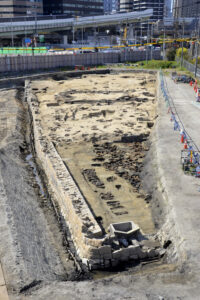 The remains of more than 1,500 individuals from the 19th century have been discovered in a historic burial ground in Osaka. This is the greatest number of burials ever discovered in one place in the city.
The remains of more than 1,500 individuals from the 19th century have been discovered in a historic burial ground in Osaka. This is the greatest number of burials ever discovered in one place in the city.
The city has been conducting excavations at the site since 1991. The most recent archaeological survey focused on the eastern end of the burial ground due to a planned expansion of Osaka Station. The site was once known as Umeda Haka (Umeda Grave) and was one of seven major cemeteries in the city of Osaka. It was active from the Edo (1603-1868) to the Meiji era (1868-1912).
 Archaeologists unearthed a stone wall noted on an 1890 map that forms the east boundary of the graveyard and more of the north-south wall that was first encountered in the 2016-2017 dig. To the north of the stone wall were hundreds of simple burials. The deceased were interred in shallow pits and covered with about three feet of soil. Multiple bodies were layered on top of each other. These are likely victims of an epidemic who had to be buried quickly. Lesions have been found on their extremities which might be indicative of what killed them. Syphilis is one possibility, as it was known to be widespread in urban centers during the late Edo, early Meiji period.
Archaeologists unearthed a stone wall noted on an 1890 map that forms the east boundary of the graveyard and more of the north-south wall that was first encountered in the 2016-2017 dig. To the north of the stone wall were hundreds of simple burials. The deceased were interred in shallow pits and covered with about three feet of soil. Multiple bodies were layered on top of each other. These are likely victims of an epidemic who had to be buried quickly. Lesions have been found on their extremities which might be indicative of what killed them. Syphilis is one possibility, as it was known to be widespread in urban centers during the late Edo, early Meiji period.
 In the southern section of the cemetery, the team unearthed a large rectangular building with a stone foundation. The cornerstone was set in a trench that was backfilled with bone ash soil. Its purpose is unclear, but archaeologists think it may have been an ossuary. On the north and south sides of the building were a dense grouping of casket burials, including enclosed wooden caskets and circular open containers like barrels. Artifacts found inside the graves include juzudama (prayer beads, combs, clay dolls and rokusenmon (a set of six coins used to pay passage across the river to the afterlife). The team also unearthed a group of about 350 earthenware urns in a depository of bone ash from cremations.
In the southern section of the cemetery, the team unearthed a large rectangular building with a stone foundation. The cornerstone was set in a trench that was backfilled with bone ash soil. Its purpose is unclear, but archaeologists think it may have been an ossuary. On the north and south sides of the building were a dense grouping of casket burials, including enclosed wooden caskets and circular open containers like barrels. Artifacts found inside the graves include juzudama (prayer beads, combs, clay dolls and rokusenmon (a set of six coins used to pay passage across the river to the afterlife). The team also unearthed a group of about 350 earthenware urns in a depository of bone ash from cremations.
 Researchers believe this cemetery was used by the commoners who lived outside the Osaka Castle compound. The average age of death was around 30 years old, and the remains of many children have been found there. Archaeologists hope that analysis of the bones and grave goods will shed new light on the lives of the non-aristocratic people of Osaka who have been sorely neglected in historical records.
Researchers believe this cemetery was used by the commoners who lived outside the Osaka Castle compound. The average age of death was around 30 years old, and the remains of many children have been found there. Archaeologists hope that analysis of the bones and grave goods will shed new light on the lives of the non-aristocratic people of Osaka who have been sorely neglected in historical records.
The remains and artifacts excavated are now being documented and analyzed. Results of the survey are expected to be published next year.